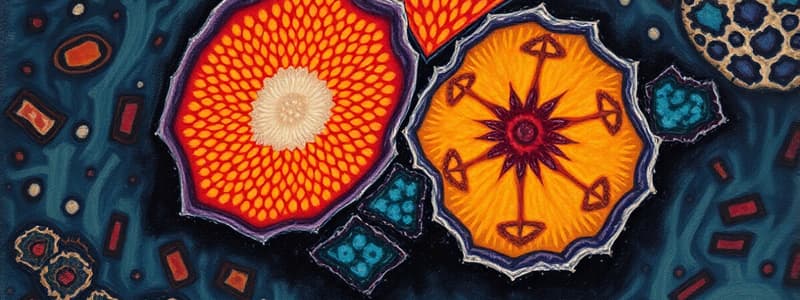Podcast
Questions and Answers
Which cell type is described as having a multilobed nucleus?
Which cell type is described as having a multilobed nucleus?
- Monocyte
- Eosinophil
- Basophil
- Neutrophil (correct)
Eosinophils have a shape described as rounded.
Eosinophils have a shape described as rounded.
False (B)
What is the shape of a monocyte?
What is the shape of a monocyte?
Kidney-shaped
The liver is known for its _____ shape when stained with H&E.
The liver is known for its _____ shape when stained with H&E.
Match the following blood cells with their descriptions:
Match the following blood cells with their descriptions:
What kind of cell is often multinucleated?
What kind of cell is often multinucleated?
Fat cells are identified by a peripheral shape.
Fat cells are identified by a peripheral shape.
Where are phospholipids commonly found?
Where are phospholipids commonly found?
The two main types of endoplasmic reticulum are _____ and smooth.
The two main types of endoplasmic reticulum are _____ and smooth.
Which organelle is responsible for energy production in the cell?
Which organelle is responsible for energy production in the cell?
What is the primary function of the centrosome?
What is the primary function of the centrosome?
Flashcards
Phospholipid
Phospholipid
A type of lipid with a hydrophilic head and hydrophobic tail, forming the structural basis of cell membranes.
Rough Endoplasmic Reticulum (RER)
Rough Endoplasmic Reticulum (RER)
The rough endoplasmic reticulum is involved in protein synthesis and modification; it is studded with ribosomes.
Smooth Endoplasmic Reticulum (SER)
Smooth Endoplasmic Reticulum (SER)
The smooth endoplasmic reticulum is involved in lipid metabolism, detoxification, and calcium storage; it lacks ribosomes.
Mitochondria
Mitochondria
Signup and view all the flashcards
Centrosome
Centrosome
Signup and view all the flashcards
Lymphocyte
Lymphocyte
Signup and view all the flashcards
Eosinophil
Eosinophil
Signup and view all the flashcards
Basophil
Basophil
Signup and view all the flashcards
Neutrophil
Neutrophil
Signup and view all the flashcards
Monocyte
Monocyte
Signup and view all the flashcards
Study Notes
Cell Structure Diagrams
- Various diagrams depict different cell structures and components. These include cell membranes, various types of cells, and cell organelles.
Microscopic Images
- Images of tissues and cells are displayed, showing variations in cell types, sizes, and structures. The images include stained samples, demonstrating the way certain cellular components are highlighted under a microscope.
Tissue Types
- Different tissue types are shown, including liver, kidney, muscle, and blood.
Cell Organelles
- Images depict cell organelles like mitochondria and the Golgi apparatus. Specific cellular components are labeled.
Cellular Processes
- Diagrams illustrate cellular processes, showing transport vesicles and the Golgi apparatus's role in secretion.
Cytoskeleton Components
- The cytoskeleton, a complex framework within cells, is visualized with depictions of its components.
Blood Cell Images
- Blood cell types and their varied characteristics are exemplified.
Histology Study
- The study involves the examination and identification of different tissues, cells, and structures through microscopic visualization. The presentation encompasses variations in tissue structures, providing examples of how tissues (and cells within) react to different conditions.
Types of Epithelial Cells
- The images provide visual examples of cuboidal, columnar, and transitional epithelial cells. Variations including the presence of cilia are shown.
Cell Nuclei
- Images show different shapes of cell nuclei, as seen through microscopic techniques (like different staining techniques). This includes spherical, bilobed, and multi-lobed types.
Additional details
- Various labels and annotations are shown, clarifying the components present in each image.
- Several images show tissue structures.
- Different staining methods and labels are used on the images to distinguish cellular features.
Studying That Suits You
Use AI to generate personalized quizzes and flashcards to suit your learning preferences.



